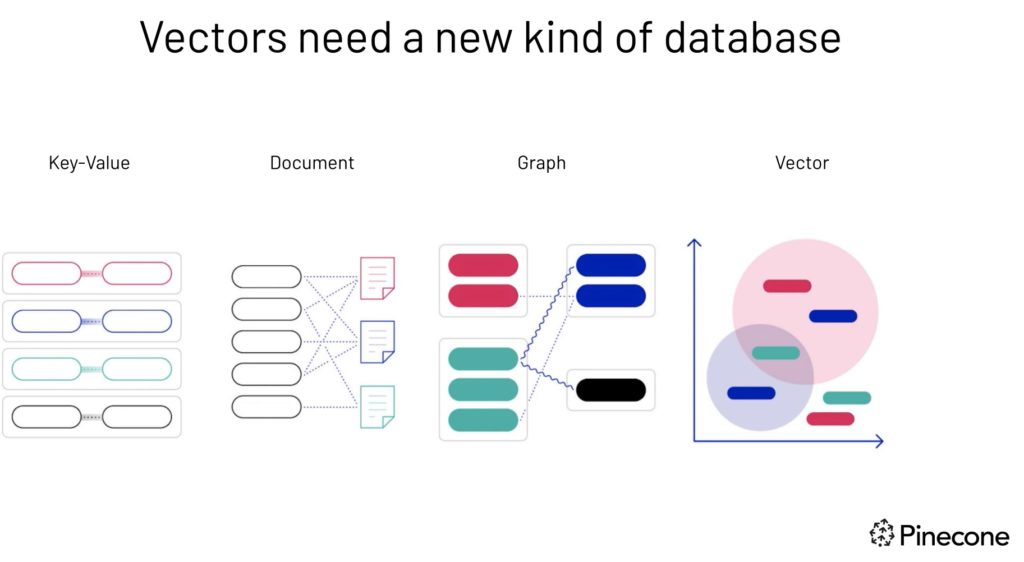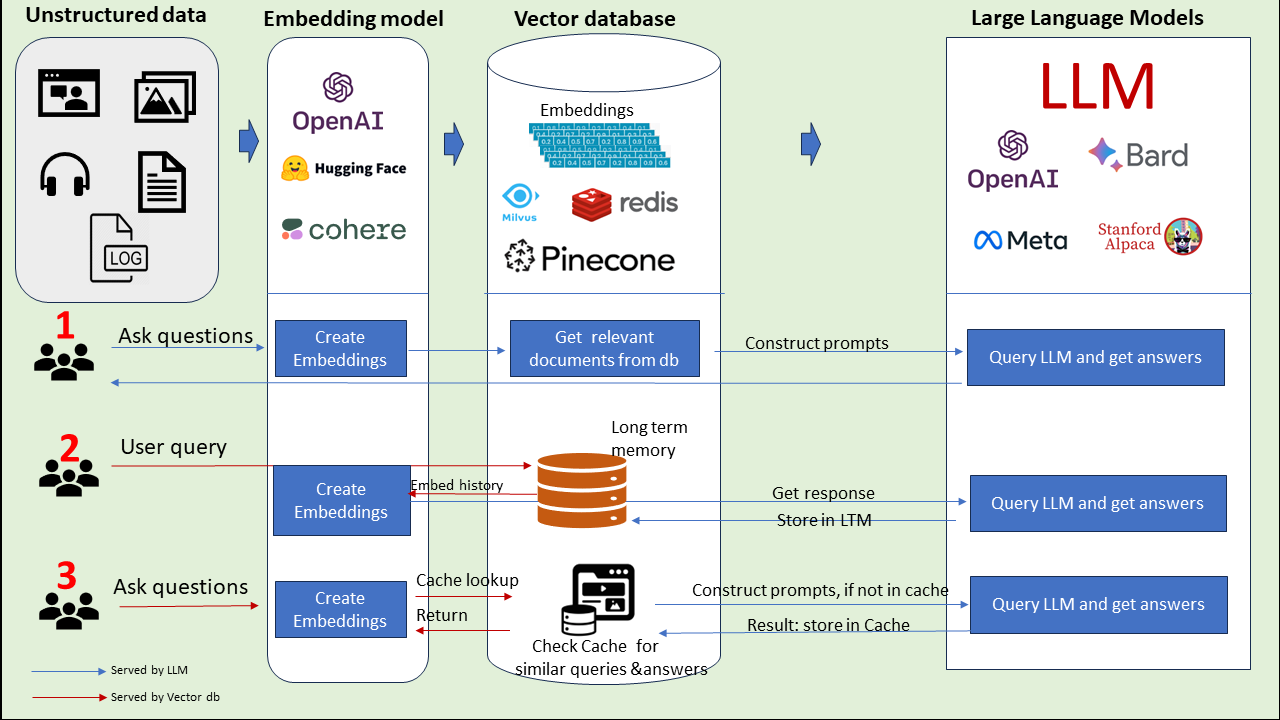Maximize Your Chatbot's Smarts with Vector Databases
November 16th, 2023

Maximize Your Chatbot's Smarts with Vector Databases
Leveraging Vector Databases for Chatbot Intelligence
As the digital landscape evolves, efficient data management has become crucial for applications powered by artificial intelligence, particularly in the realm of conversational chatbots like ChatGPT. The traditional databases that once served as the backbone for storing and retrieving information are being outpaced by the complex needs of AI-driven systems that require rapid access to vast amounts of nuanced data. Vector databases emerge as a game-changer in this scenario, designed specifically to handle the intricacies of high-dimensional data, which is characteristic of natural language processing tasks. By employing vector databases, chatbot technologies can not only process user queries with greater precision but also deliver responses with unprecedented relevance and speed. This marks a significant leap forward in creating conversational experiences that are remarkably human-like, transforming how businesses and consumers interact with AI platforms. With the rise of AI and machine learning, the ability to seamlessly integrate vector databases stands as a pillar for the next generation of intelligent chatbot applications.

Understanding vector databases
Difference between vector and traditional databases
As we delve into the world of databases, it's crucial to distinguish between traditional databases and their vector counterparts. Traditional databases, such as relational database management systems (RDBMS), store data in tables, which can be queried using SQL (Structured Query Language). They're optimized for transaction processing and are adept at handling a wide range of query types. However, when it comes to complex operations like similarity search or pattern matching, they may not offer the most efficient performance.
Vector databases, on the other hand, are designed specifically to handle high-dimensional vector data, which is common in machine learning and artificial intelligence applications. Instead of rows and columns, vector databases use mathematical vectors to represent and store data. Each piece of data, whether it’s an image, text, or sound, is converted into a vector in a multi-dimensional space.
The core storage differences are evident when considering how each database handles queries. In a traditional database, a search might involve scanning through multiple rows and columns to find matches based on specific criteria, which can be time-consuming. Vector databases streamline this process by utilizing distance measures in vector space to quickly locate the nearest neighbors - essentially finding the most similar items based on vector proximity rather than exact matches.
This fundamental difference in data storage and retrieval makes vector databases especially suited for tasks that require finding patterns or similarities within large datasets, a feature that is invaluable for chatbots and other AI-driven applications where understanding context and nuances is essential.
Benefits of using vector databases in AI applications
Vector databases are increasingly becoming a game-changer in the world of artificial intelligence (AI), particularly for applications that require rapid and efficient data retrieval and analysis. The unique structure and design of vector databases offer several advantages that are especially beneficial in the context of AI:
Enhanced Search Efficiency
AI applications often need to sift through vast amounts of data to find patterns, make predictions, or understand natural language queries. Vector databases excel in this area by utilizing vectors — numerical representations of data points — which allow for faster and more precise searches compared to traditional database structures. By converting complex information into vectors, these databases can perform similarity searches at incredible speeds. This efficiency is crucial for AI applications where response time is critical, such as real-time recommendation systems or interactive chatbots.
Improved Data Handling Capabilities
Another advantage of vector databases lies in their superior data handling capabilities. In an AI context, data comes in various forms and structures, including unstructured text, images, and sound. Vector databases handle this polymorphism gracefully by representing different types of data in a consistent vector space. This uniformity simplifies the processing and comparison of heterogeneous data sources, enabling AI applications to extract insights from a rich tapestry of information sources without the need for extensive preprocessing.
By leveraging vector databases, AI applications can not only improve their core functionalities but also expand their capabilities by accommodating diverse data types and extracting value from them efficiently. As AI continues to evolve and integrate with various sectors, the use of vector databases is poised to become a fundamental component in building intelligent and responsive systems that meet the demands of users and businesses alike.

Integrating vector databases with chatbot platforms
Step-by-step integration guide
Integrating a vector database into your chatbot application can significantly enhance its ability to understand and respond to complex user queries. To do so effectively, it's important to follow a methodical approach. Here is a step-by-step guide to help you through the setup and configuration process.
Selecting the Right Vector Database: Before any technical steps are taken, identify which vector database fits best with your chatbot’s requirements. Consider factors such as scalability, speed, compatibility, and the nature of your data.
Installation: Follow the specific installation guidelines provided by the vector database you have chosen. This will typically involve downloading the database software from the official website or a repository, and running the installation commands on your server.
Configuration: After installation, configure the database according to your needs. This often involves editing configuration files where you set parameters like memory allocation, network settings, and security options. Check the database documentation for guidance on these settings.
Connecting to Your Chatbot: Establish a connection between your chatbot platform and the vector database. This usually requires adding the database's connection string or API credentials to your chatbot's configuration files or through environment variables.
Creating Schemas and Indexes: Design the schema for your data that reflects the type of information your chatbot will process. Then, build indexes to optimize search performance. In the context of vector databases, this means defining the vector fields and the dimensions of the vectors that represent your data.
Data Ingestion: Import existing data into your vector database. Depending on the size and complexity of your data, you may need to use data migration tools or write custom scripts to transfer and transform data into the vector format required by the database.
Testing Connectivity and Functionality: Once the data is ingested, test the connectivity between the chatbot and the database. Ensure that the chatbot can not only retrieve but also update, delete, and insert records as necessary.
Optimizing Searches: Fine-tune the vector search capabilities. Run queries from your chatbot through the database to ensure that results are accurate and relevant. Adjust ranking functions, similarity measurements, and other search parameters as needed.
Securing Your Integration: Implement security measures such as encryption, access controls, and auditing to protect your vector database and its integration with the chatbot.
Deployment: Move the integrated system from a development or staging environment into production. Monitor the deployment closely for any issues and be ready to rollback if necessary.
Monitoring and Maintenance: Set up monitoring tools to keep an eye on the performance and health of the vector database. Regularly check logs, analyze query performance, and update the database software to ensure everything runs smoothly.
By following these configuration steps and setup instructions diligently, you will lay a solid foundation for a robust and intelligent chatbot application that can handle complex queries with improved precision and speed.
Troubleshooting common integration issues
When integrating vector databases into chatbot platforms, developers often encounter a variety of challenges that can impact the performance and functionality of the application. Understanding these common issues and their corresponding solutions is crucial for maintaining a seamless user experience.
Issue 1: Connection Failures
A frequent stumbling block during integration is the failure to establish a connection between the chatbot platform and the vector database. This could be due to incorrect configuration settings or network problems.
Solution: Verify all connection strings and credentials are accurate. Ensure that there are no firewall or network restrictions that could be blocking communication between the server hosting your chatbot and the vector database. If necessary, consult the database's documentation for guidance on configuring a secure and reliable connection.
Issue 2: Incompatibility with Chatbot Libraries
Sometimes, the existing libraries or frameworks used by your chatbot may not be fully compatible with the vector database API.
Solution: To address this, you may need to update the libraries to the latest versions that support the database or look for alternative libraries that offer compatibility. If there are no compatible libraries available, consider writing custom middleware that can serve as a bridge between your chatbot and the vector database.
Issue 3: Poor Query Performance
After successfully connecting, you might notice that queries to the vector database are slower than expected, which can lead to delays in the chatbot's responses.
Solution: Optimize your queries by reviewing the indexing and search parameters within the vector database. Make use of efficient vector similarity measures and ensure that you're using batched queries when appropriate to reduce latency. Additionally, examine the resource allocation for the database to confirm that it has sufficient computing power to handle the workload.
Issue 4: Data Synchronization Errors
Data synchronization errors can occur when there is a lag or inconsistency between the chatbot's knowledge base and the data stored in the vector database.
Solution: Implement a robust data synchronization protocol that regularly updates the vector database with the latest information. Use event-driven architectures or webhooks to trigger updates immediately after data changes. Consistency checks should be scheduled to ensure both systems reflect the same information.
Issue 5: Security Vulnerabilities
Integrating a vector database can sometimes open up new security vulnerabilities, particularly if the integration isn't properly secured.
Solution: Strengthen security measures by enforcing encryption for data in transit and at rest, utilizing authentication tokens, and following best practices for API security. Regularly audit the system for potential vulnerabilities and stay updated on the latest security protocols for your vector database.
By preemptively addressing these common integration issues, you can ensure that the incorporation of a vector database enhances your chatbot’s capabilities without compromising on reliability or user satisfaction.
Enhancing chatbot functionality with vector search
Improving response time and relevance
In the fast-paced digital landscape, quick and accurate responses are crucial for maintaining user engagement in chatbot interactions. Vector databases have a significant impact on reducing response time while simultaneously increasing the relevance of a chatbot's answers to user queries.
When it comes to response time, vector databases excel by enabling efficient indexing and retrieval of high-dimensional data, which is often used to represent complex language queries in a chatbot context. This allows for rapid comparison of user input against a vast array of potential responses or information snippets stored within the database. The use of vector search algorithms means that the chatbot can sift through large volumes of data at an accelerated pace compared to traditional database queries. As a result, users experience almost instantaneous feedback from the chatbot, fostering a smoother and more natural conversational flow.
Relevance of responses is another critical factor determining a chatbot's effectiveness. By utilizing vector databases equipped with machine learning models, chatbots can interpret the semantic meaning behind user inquiries more accurately. These databases convert text into numerical vectors that capture the contextual nuances of language, allowing the chatbot to match questions with the most semantically relevant answers. This process not only improves user satisfaction but also helps in building trust towards the chatbot as a reliable source of information.
To measure and optimize both response time and relevance, it's essential to track various performance metrics. Key indicators include average response time, which measures the speed of the chatbot's replies, and precision-recall metrics, which assess whether the responses provided are both correct and helpful to the user. Monitoring these metrics over time helps developers fine-tune the underlying vector database configurations and machine learning models, ensuring that the chatbot continues to deliver high-quality, timely interactions as it scales and as user demands evolve.
By harnessing the power of vector databases, developers can significantly enhance the user experience offered by chatbots like ChatGPT, ensuring that they are not only fast but also deeply attuned to the informational needs of their users.
Case studies: vector search in action
Vector search technology is revolutionizing the way chatbots understand and respond to user queries, providing more relevant results and improving overall customer experience. By examining some real-world examples, we can see the transformative impact of vector databases on conversational AI.
Real-World Examples of Vector Search in Chatbots
One notable success story is the implementation of vector search for a leading e-commerce chatbot. This retail giant integrated a vector database to handle customer service inquiries. Initially, their chatbot struggled with understanding the nuances in customer questions, often returning generic or unrelated product recommendations. After adopting a vector search approach, the chatbot began accurately interpreting customer intent, drastically improving its suggestions and substantially increasing sales conversions and customer satisfaction.
Another impressive example comes from the financial sector. A major bank employed vector search capabilities within its customer support chatbot to comprehend and process complex financial queries. Previously, customers would become frustrated with the bot's inability to grasp intricate investment-related questions. With vector search, the chatbot can now sift through vast amounts of financial data, offering precise, personalized advice that was once only possible through human financial advisors.
In the healthcare domain, vector search has empowered a virtual health assistant to provide more accurate medical information and guidance. The integration of a vector database allowed the chatbot to parse complicated medical terminology and patient input, promptly directing users to appropriate care paths and reducing wait times for critical health consultations. This advancement not only improved patient engagement but also lightened the load on healthcare professionals by handling routine inquiries.
These success stories underscore the potential of vector databases to enhance the performance of chatbots across various industries. As businesses continue to adopt this technology, we are likely to witness even more innovative applications that push the boundaries of AI-driven communication.
Scaling your chatbot with vector databases
Strategies for effective scaling
As chatbot applications gain popularity and user bases grow, it's crucial to have robust scaling strategies in place to handle increased traffic without hiccups. One of the most effective methods for scaling vector databases in chatbot systems is implementing load balancing techniques. Load balancing is a process where incoming requests are distributed across multiple servers or databases. This not only helps in managing large volumes of interactions seamlessly but also ensures that no single server bears too much strain, which could lead to slow response times or even outages.
To implement load balancing with vector databases, developers can use a variety of tools and approaches. For instance, a common strategy is to use a dedicated load balancer that sits in front of the database cluster. This load balancer can monitor the demand on each server and route new requests to the server with the lowest current load, thus equalizing the work each server performs and preventing any one server from becoming a bottleneck.
Another key aspect of scaling strategies for vector databases is to anticipate future load and adjust resources accordingly. This proactive approach involves analyzing usage patterns and trends to predict when more resources will be needed. With this insight, you can scale your database horizontally (adding more machines) or vertically (upgrading existing hardware) well ahead of peak demand periods.
It's also important to ensure that the vector database and chatbot application are designed to be stateless, meaning they do not rely on local data storage. A stateless architecture allows for any request to be handled by any server in the pool, which is compatible with the concept of load balancing and essential for horizontal scaling.
In addition to these technical strategies, it's also beneficial to implement monitoring systems to track the health and performance of your vector databases. These systems can provide real-time alerts when certain thresholds are breached, enabling quick action to redistribute load or add resources as necessary to maintain smooth operation of the chatbot application.
By adopting these scaling strategies, developers can ensure their chatbot applications are ready to grow with their user base while maintaining high performance and reliability.
Monitoring and maintaining database performance
Keeping your vector database operating smoothly is crucial for ensuring that your chatbot application continues to function effectively. Performance monitoring involves regularly checking various metrics related to the database's operations, such as query response times, indexing speeds, and overall system throughput. By establishing a robust monitoring routine, you can identify potential bottlenecks or issues before they impact the user experience.
To get started with performance monitoring, it's essential to utilize the right tools. Many vector databases come with built-in analytics dashboards that provide real-time insights into performance metrics. Additionally, external monitoring services can be integrated to offer a more comprehensive view of the database health across different layers of your application stack.
Maintenance best practices for vector databases include regular updates to ensure you have the latest features and security patches. It's also important to clean up and optimize indices periodically, as over time, data can become fragmented, leading to slower search performance. Another key practice is to implement automated backup and recovery procedures, which safeguard against data loss due to system failures or other unforeseen events.
Furthermore, consider setting up alert systems to notify your team of any performance anomalies. This proactive approach enables immediate investigation and resolution of issues, maintaining the seamless operation of your chatbot.
Appropriate hardware scaling is also part of maintenance. As your user base grows and query volumes increase, you may need to scale up your hardware resources or distribute the load across multiple servers. Vector databases often support clustering and sharding, which are effective strategies for managing large datasets and high-traffic environments.
Finally, continuous testing and optimizing of database queries can lead to significant improvements in performance. Regularly evaluate how queries align with your data structure and make adjustments to indexes and query parameters to achieve the fastest possible access times.
By integrating these performance monitoring and maintenance best practices into your operational routines, you can ensure that your vector database remains a robust backbone for your chatbot platform, delivering fast, accurate, and reliable interactions to users at all times.
Future trends in vector databases and conversational AI
The intersection of vector databases and conversational AI is a hotbed for innovation, with numerous technological advancements on the horizon that promise to redefine how we interact with machines. As we look towards the future, one significant trend likely to shape this space is the deepening integration of predictive analytics into chatbot systems. By leveraging vast amounts of data and powerful machine learning models, conversational AI can anticipate user needs and provide more proactive and personalized responses.
This predictive capability will be bolstered by continuous improvements in vector database technology. The ability to process and understand complex queries in natural language is set to become even more sophisticated, thanks to the development of more advanced algorithms that can parse nuanced human speech patterns. In turn, this enhanced comprehension enables chatbots to engage in more meaningful and contextually relevant dialogues, more closely mimicking human-to-human interaction.
Moreover, we are witnessing the rise of self-learning chatbots that evolve through each interaction. Powered by technology advancements in both hardware and software, these chatbots use feedback loops to refine their response mechanisms, becoming more accurate over time. This evolution is partly driven by edge computing, which allows for faster processing at or near the source of data collection, thus reducing latency and improving the overall user experience.
Another upcoming trend involves blending conversational AI capabilities with other forms of biometric data, such as facial expressions or voice intonation. This integration enables a richer understanding of the user's emotional state, allowing chatbots to offer tailored responses that account for mood or sentiment. As a result, interactions are not only informative but also empathetic, fostering a deeper connection between the user and the AI.
Finally, as we embrace an increasingly interconnected world, we will see vector databases play a pivotal role in multi-modal AI applications. These systems process and synthesize information from various sources, including text, voice, images, and sensors, delivering an omni-channel experience that aligns with users' preferences and behaviors across different platforms.
In summary, the synergy between vector databases and conversational AI points to a future where digital assistants are not just reactive but strikingly intuitive, able to predict user intentions and provide insightful assistance before a user even articulates a request. As these technologies co-evolve, the potential for creating truly intelligent and conversational interfaces seems limitless, heralding a new era of digital communication. The evolution of conversational AI is a testament to the incredible strides we've made in technology, and vector databases stand at the forefront of this revolution. By harnessing their power, developers are able to build chatbots that not only understand but also anticipate user needs with unprecedented accuracy. The integration of vector databases has moved us closer to creating digital assistants that mirror human intelligence, making interactions more natural and efficient.
Upgrading chatbot platforms with vector search capabilities allows for handling complex queries and managing high traffic volumes effortlessly, ensuring scalability and reliability. As the line between human and machine continues to blur, the role of vector databases in shaping future trends of conversational AI cannot be overstated. Chatbots like ChatGPT are no longer just tools; they are evolving into intuitive companions capable of understanding the nuances of human language and providing meaningful engagement.
Embracing vector databases is not just about staying current with technological advancements; it's about pioneering the next wave of digital communication. With the information provided, businesses and developers can confidently stride into a future where chatbots become an indelible part of our daily lives, enhancing our interactions, and broadening the horizons of what artificial intelligence can achieve. Whether you're a tech enthusiast, a developer, or simply someone intrigued by the potential of AI, the fusion of vector databases and chatbots marks a thrilling juncture in the narrative of progress.
Other articles
August 18th, 2023
SDXL ControlNET – Easy Install Guide / Stable Diffusion ComfyUI
s and Nodes. This Method … read more...
October 12th, 2023
Ultimate Guide to Using GPT for Blog Drafting
nd optimization strategies for best results. read more...
October 13th, 2023
Leveraging Generative AI in Everyday Life and Work
ional operations, while maintaining ethical standards. read more...




